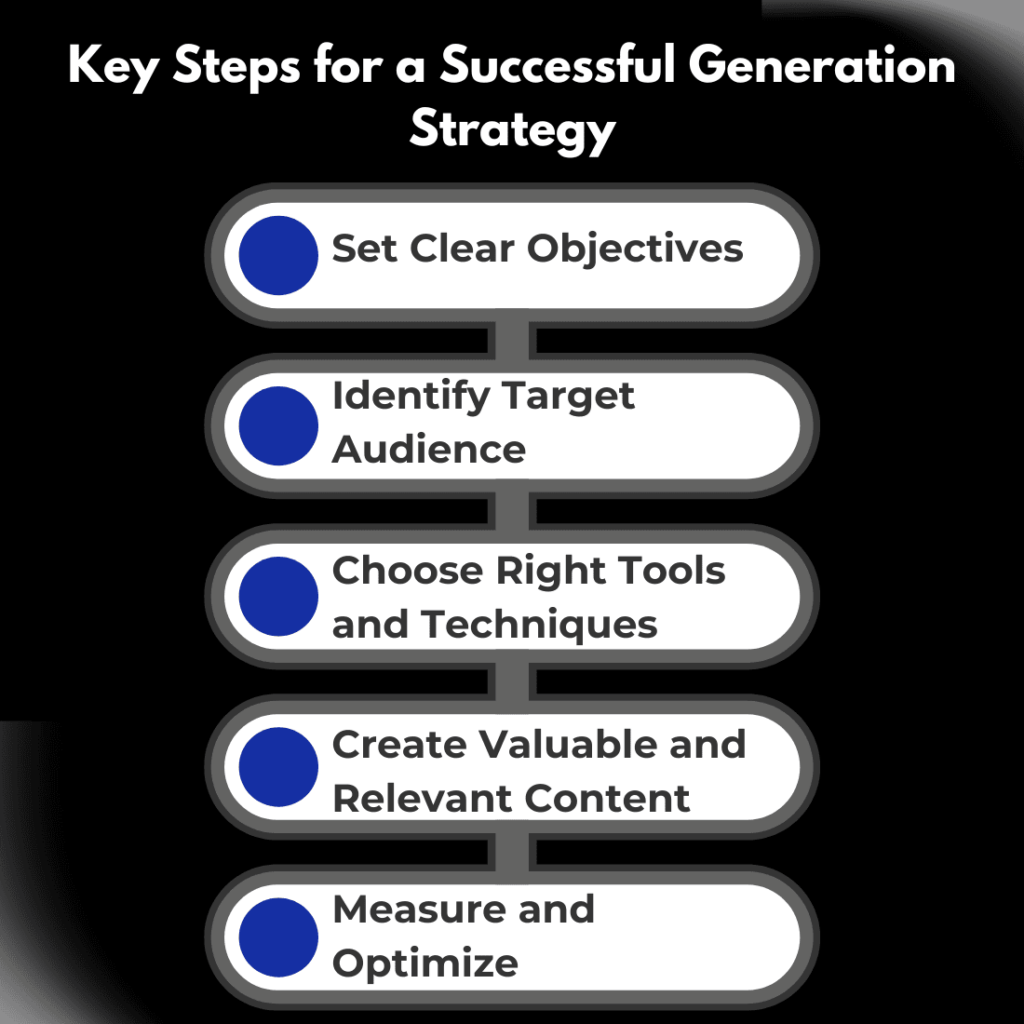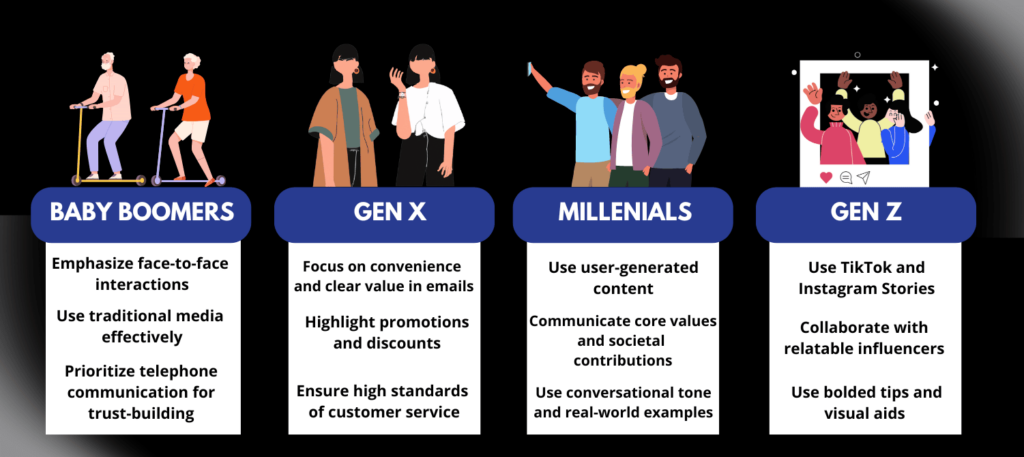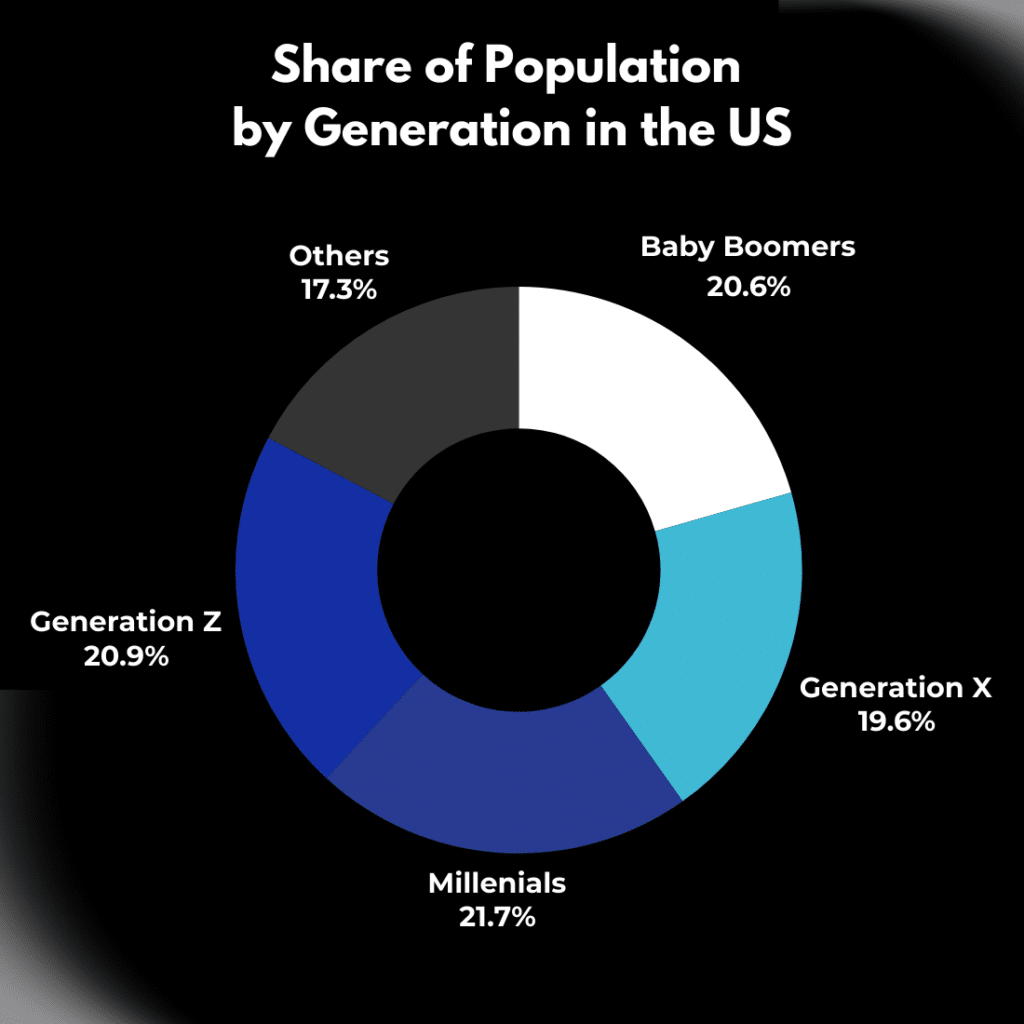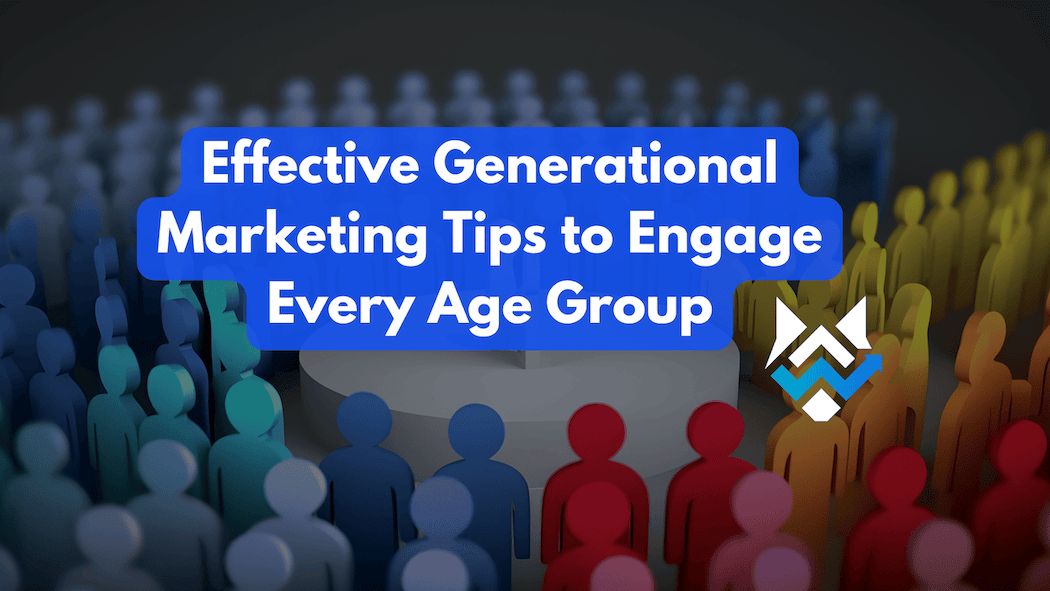Understanding and engaging with different generations through generational marketing is crucial for any successful marketing strategy. Integrating these techniques ensures that your approach resonates with a wide array of age groups, enhancing your brand’s reach and effectiveness.
This blog explores effective strategies for engaging Baby Boomers, Gen X, Millennials, and Gen Z, drawing insights from industry experts.
Understanding Generational Marketing
Generational marketing is a marketing approach that segments the population into cohorts based on their age, typically grouping them by the generation they belong to. Each generational cohort shares similar experiences, attitudes, values, and life stages, all of which influence their purchasing behavior. Therefore, understanding these nuances helps marketers tailor their strategies and messages to resonate more deeply with each specific group.
The importance of generational marketing stems from the recognition that different age groups have distinct preferences, media consumption habits, and communication styles. With these insights, businesses can therefore craft targeted campaigns that are more likely to engage and convert their intended audience, ultimately resulting in a higher return on investment for their marketing efforts.

What is a Generation Strategy?
A generation strategy refers to a comprehensive plan designed to produce specific outcomes, such as leads, ideas, or content, through targeted actions and processes. It encompasses the methods, tools, and techniques used to attract, engage, and convert potential customers or generate valuable insights and innovations.
Types of Generation Strategies
Lead Generation Strategy
- A lead generation strategy focuses on attracting and converting prospects into potential customers. It involves identifying and nurturing individuals who show interest in your products or services.
- Key Components:
- Content Marketing: Creating valuable and relevant content to attract and engage prospects.
- SEO: Optimizing your website and content to rank higher in search engine results.
- Social Media Marketing: Utilizing social platforms to reach and interact with your target audience.
- Email Marketing: Using email campaigns to nurture leads and guide them through the sales funnel.
Idea Generation Strategy
- An idea-generation strategy aims to foster creativity and innovation within an organization. It involves generating new ideas that can lead to product development, process improvement, or business growth.
- Key Components:
- Brainstorming Sessions: Encouraging team collaboration to generate diverse ideas.
- Market Research: Analyzing market trends and customer feedback to identify opportunities.
- Innovation Workshops: Conducting workshops to inspire creative thinking and problem-solving.
- Crowdsourcing: Engaging external communities to contribute ideas and solutions.
Content Generation Strategy
- A content generation strategy focuses on producing high-quality content that resonates with your target audience. It aims to establish your brand as a thought leader and drive engagement.
- Key Components:
- Content Planning: Developing a content calendar to ensure consistent and strategic content production.
- Audience Research: Understanding your audience’s preferences and pain points to create relevant content.
- Multimedia Content: Utilizing various formats, such as blogs, videos, infographics, and podcasts, to reach a wider audience.
- Analytics: Monitoring content performance to refine and optimize future content efforts.
Overview of Generations
Baby Boomers
Born between 1946 and 1964, Baby Boomers are known for being hardworking and value-driven. They tend to be brand loyal and prefer quality products and services. Boomers are less digital-native than younger generations but are increasingly adopting technology like social media and smartphones.
Gen X
Gen X refers to individuals born between 1965 and 1981. This generation values work-life balance, is self-reliant, and is skeptical of traditional advertising. They often research products thoroughly before purchasing and are influenced by both online and offline sources.
Millennials
Millennials, also known as Gen Y, were born between 1982 and 1997. They are characterized by their tech-savvy and are highly engaged with content on mobile devices and social platforms. They value authenticity, experiences, and social responsibility from brands.
Gen Z
The youngest cohort, Gen Z, includes those born from 1997 onwards. They are true digital natives who have grown up with the internet and social media. Gen Z is socially conscious, and seeks personalization in marketing, while also tending to have shorter attention spans. Therefore, making quick and engaging content is a necessity for capturing their interest.
Tailoring Strategies for Each Generation

Baby Boomers
In navigating the diverse landscape of generational marketing, a precise understanding of each age group’s preferences is paramount. When directing efforts toward Baby Boomers—born between 1946 and 1964—there’s a distinctive appreciation for traditional media and personal touch in transactions.
The considerable value they place on face-to-face interactions should not be underestimated. Engaging this demographic effectively requires leveraging channels such as in-person meetings, events, and tangible direct mail. Brochures, newspapers, and magazines are potent ways to transmit information to Baby Boomers, who spend more time with physical media than digital alternatives.
Organizations should also consider the reliability of telephone communications over more modern methods. A professional tone in these interactions instills trust and reflects the high standards of customer service that Baby Boomers hold in esteem. Additionally, it’s essential to provide clear and accessible information due to their preference for thorough details before making informed decisions.
Generation X
Born between 1965 and 1980, members of Generation X are often characterized by their balanced approach to work and life, including how they engage with brands. They are tech-savvy yet still appreciate the practicality and personalized nature of traditional marketing.
Email campaigns serve as an efficient tool to reach this generation, as they mesh well with their busy lifestyles. Therefore, these should be crafted with a focus on convenience and providing clear value, avoiding superfluous content in favor of informative, straightforward messages. Additionally, promotions, discounts, or loyalty programs communicated via email can entice Gen Xers, since they seek both quality and value in their transactions.
Businesses must emphasize reliability and customer service when targeting Generation X, ensuring that all engagements affirm the company’s credibility. Offering practical solutions through a dependable product or service aligns perfectly with the preferences of this self-reliant and resourceful demographic.
Millennials
Millennials born between 1981 and 1996 are a digitally native generation that responds to an engaging and motivational approach. For successful outreach, one must dive into the social media realm, tapping into platforms where millennials are active daily participants.
User-generated content is a powerful magnet for millennials, as it showcases authenticity and fosters a sense of community. By encouraging customers to share their experiences, brands can therefore cultivate a relatable image and enhance credibility through peer endorsements.
It’s paramount to note that millennials resonate with companies that stand for something beyond profit. Therefore, branding should always communicate core values and societal contributions, creating a narrative that aligns with the aspirations and ethics of this cohort. Businesses adopting a conversational tone, peppered with real-world examples, can better connect with millennials by speaking their language and addressing their unique worldviews.
Generation Z
Generation Z, born from 1997 onward, is immersed in the fast-paced digital environment. To capture the attention of this savvy cohort, brands need to adopt a trendy and dynamic mode of communication. Short-form video content, popularized by platforms like TikTok and Instagram Stories, is an essential component of contemporary marketing strategies aimed at Gen Z.
Forging partnerships with influencers who resonate with Generation Z can significantly amplify a brand’s presence within this demographic. Such collaborations can drive engagement through authentic and relatable content that feels less like traditional advertising and more like a peer recommendation.
A style that incorporates bolded tips and visual aids specifically caters to the quick consumption habits of Gen Z, helping them absorb information rapidly. Furthermore, energizing and direct communications appeal to their desire for immediacy and interactivity. Therefore, embodying a sense of ‘nowness’ in marketing efforts makes a striking impact on this future-forward generation.
Comprehensive Cross-Generational Marketing Strategies
A unified approach in branding and messaging not only fosters recognition but also builds trust among a wide-ranging audience. Here are detailed strategies to ensure consistency and personalization in your marketing efforts.
Ensuring Consistent Brand Messaging Across Generations
A brand’s ability to maintain a consistent message across various channels and mediums is therefore fundamental in appealing to a multi-generational audience. Additionally, aligning all communications with the company’s core values and mission statement is key to building a strong, trustworthy brand presence.
Strategies for Consistency
- Unified Visual Identity
- Cohesive Color Scheme: Implement a color scheme that reflects the brand’s ethos and is used consistently across all marketing materials.
- Logo Consistency: Ensure the logo is utilized in a standard format across all platforms to reinforce brand recognition.
- Typography Guidelines: Maintain consistent typography that complements the brand’s visual identity and enhances readability.
- Tone and Voice
- Brand Personality Reflection: Craft a brand voice that is distinctive and reflective of the company’s personality, ensuring it is used consistently whether in social media posts, email campaigns, or customer service interactions.
- Uniformity Across Channels: Achieve a harmonious tone and style across all communication channels to solidify the brand’s voice.
- Core Messaging
- Key Point Distillation: Convey central messages by distilling them into key points that remain impactful and recognizable across different mediums. This way, you ensure the core message is never diluted.
Personalization: Engaging Each Generation Individually
The significance of personalized marketing cannot be overstated when it comes to connecting with individuals from different generations. Through data analytics, marketers can create campaigns that resonate on a personal level, acknowledging each customer’s unique preferences and behaviors.
Benefits of Personalization
- Increased Engagement
- Customized Content: Deliver content that aligns with the interests and needs of the consumer, leading to higher engagement and interaction rates.
- Higher Conversion Rates
- Individualized Promotions: Drive sales by offering promotions and product recommendations that cater to the specific desires and requirements of each customer.
- Customer Loyalty
- Understanding and Value: Foster a sense of being understood and valued, which is crucial in nurturing long-term loyalty to the brand.

Understanding US Population Distribution for Targeted Marketing
Understanding the generational breakdown of the US population is crucial for developing effective marketing strategies. The accompanying image provides a clear visualization of the share of population by generation in the US, offering valuable insights for marketers aiming to tailor their strategies to different age groups.
- Millennials
- Millennials represent the largest segment at 21.7%. This tech-savvy generation values authenticity and social responsibility. Marketing strategies should focus on digital engagement, social media presence, and showcasing a brand’s commitment to social and environmental issues.
- Generation Z
- Close behind is Generation Z at 20.9%. Known for their digital fluency, they prefer visually-driven platforms like Instagram and TikTok. Brands should prioritize creating engaging, bite-sized content and leveraging influencers to connect with this audience.
- Baby Boomers
- Baby Boomers, comprising 20.6% of the population, have significant purchasing power. This generation responds well to traditional advertising methods such as TV and print, but also appreciates user-friendly websites and email marketing.
- Generation X
- Generation X, making up 19.6%, values both digital and traditional marketing. They are inclined towards detailed product information and value-driven purchases. Email newsletters and informative content can effectively engage this group.
- Others
- The remaining 17.3% includes various smaller generational groups. A one-size-fits-all approach won’t work here. Instead, segment these audiences further and use data-driven insights to craft personalized marketing messages.
Technology Utilization: Reaching Audiences Where They Are
Embracing modern technology is vital for effectively communicating with audiences from different generational segments. Recognizing and adapting to the unique technological preferences of each group can significantly enhance the effectiveness of marketing strategies.
Approaches to Leverage Technology
- Mobile Optimization
- Universal Access: Optimize websites, emails, and other digital content for mobile devices to cater to users who predominantly access information on the go.
- Social Media Platforms
- Strategic Platform Use: Engage with various demographics by utilizing a strategic mix of social media platforms, selecting those preferred by each generation (e.g., Facebook for older generations, Instagram and Snapchat for younger cohorts).
- Automation Tools
- Streamlined Communication: To streamline the process of delivering timely, relevant, and personalized messages to different audience segments, employ marketing automation tools.
By incorporating these nuanced cross-generational marketing strategies, companies can therefore craft comprehensive campaigns that appeal to a broad spectrum of consumers. As a result, they foster an inclusive brand experience that resonates across age groups.
Conclusion
Understanding and adapting to the preferences of different generations is key to successful marketing. Therefore, by tailoring your strategies to each age group, you can enhance engagement and build stronger connections with your audience. Consequently, start implementing these generational marketing strategies today to ensure your brand resonates with every age group.
If you’re ready to discover the impact of effective generational marketing, the WolfPack team is here to help. Schedule a consultation today and receive your custom quote tailored to engage all generations.




